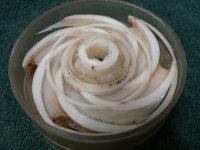I've read your posts before about the construction of the well and the previous well....it doesn't sound like it is all that big of a problem, so I wouldn't overthink it....QUOTE]
Thanks for commenting VAWellDriller !!!!!!
Whether you read this part or not in some of my previous post, our original well that was drilled in 1978 and lasted to 2013 also pumped a little sand. The reason I know this, is I now recall the sprinklers
always getting slower with age and sometimes binding as the sand wore on the swivel joint. Then in 2010, when we installed an irrigation system, I also installed a filter which was highly recommended for irrigation systems. The spin down filter allowed me to see just how much sand used to pass through the hoses and sprinklers. I now realize I was getting
approximately the same amount of sand then as I do now.
My point is, even with two different well drillers and two different wells, I getting some sand from both wells. Maybe neither was gravel packed properly or maybe it's simply the type of sand. I do know from looking at the sand, it is
extremely fine. I'm also of the belief, that is what caused issues with the first well. Over its 35 year life span, the slotted screen became partially plugged which led to low water yield.
Anyway, just my thoughts!
PS: Just before drilling a new well, I replaced the
18 year old Sears pump with a F&W pump. As stated above, the old well also pumped some sand. I took apart the pump end on the old pump before discarding and following is a photo of one of the impellers. They all looked
ROUGH, and the pump certainly wasn't pumping the amount of water that it should! What I discovered back then over the following days was 1) the pump wasn't able deliver the proper amount of water to run the irrigation system because of worn impellers
AND 2) the well was no longer able to supply enough water either. It just so happened that all of this occurred at the same time!

